For this assessment, you will create an 8-12 slide PowerPoint presentation for one or more stakeholders or leadership groups to generate interest and buy-in for the plan proposal you developed for the third assessment. Stakeholder Presentation-Interdisciplinary Team Approach Stakeholder Presentation-Interdisciplinary Team Approach As a current or future nurse leader, you may be called upon to present to stakeholders and leadership about projects that you have been involved in or wish to implement. The ability to communicate a plan—and the potential implications of not pursuing such a plan

Hello, and welcome to this stakeholder presentation. This presentation will inform you of the planned implementation of an interdisciplinary team approach to solve some issues identified following an interview with the facility’s leadership. You will get to learn about the organizational issue and its significance. The presentation will also cover the implementation and evaluation process of the Interdisciplinary team approach and the roles of the interdisciplinary teams.
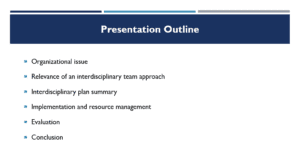
This presentation has five main sections. The first section will provide details on the organizational issue of focus. The next sections will cover the relevance of an interdisciplinary team approach in addressing the issue of concern, then the summary of the interdisciplinary plan. The next sections of the presentation will focus on the implementation of the interdisciplinary plan, resource management, and the evaluation of the plan.
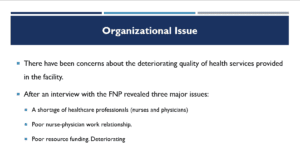
The complaints from the local community and nurses over concerns about the deteriorating quality of health services provided in the facility led to the interview with the nurse leader of the facility. The family nurse practitioner (FNP) doubles as the medical center’s administrator and primary health care provider. The interview identified three issues of concern: a shortage of healthcare professionals, both nurses and physicians, poor nurse-physician work relationships, and limited resource funding. These issues seem to be largely interrelated. The poor funding seems to contribute to the shortage of healthcare professionals and the poor work relationships and vice versa. However, the poor nurse-physician relationship contributes to poor resource funding and the facility’s understaffing. These collegial relationships affect the work environment. A study by Cristina Gasparino et al. (2021) has linked the characteristics of the professional work environment for nurses to the impact on health outcomes, the effectiveness of nurse managers in supporting nursing and other care services, and the adequacy of resources and staffing. The poor work relationship between nurses and physicians is a major organizational issue of concern.
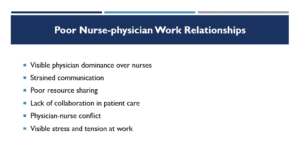
As described by the lead FNP, the nurse-physician relationships are visibly strained. The FNP noted that the nurses and physicians had strained communication based on the number of times they had to intervene. The poor nurse-physician relationships have led to poor resource sharing, affecting the ability of the facility to deliver needed patient and community care services at a time the resources are poorly funded. There have been visible conflicts between the nurses, which have further created tension and stress among the facility’s healthcare professionals leading to a total lack of collaboration during patient care. The dominance of physicians over nurses is thought to be a contributing factor to these poor nurse-physician work relationships.
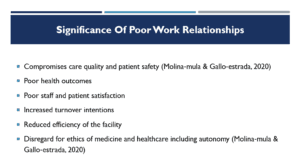
The relationship between nurses and physicians is essential within hospitals and larger healthcare settings. When poor work relationships between nurses and physicians exist, they pose a risk to the quality and safety of care provided to patients (Molina‐mula & Gallo‐estrada, 2020). Strained work relationships also contribute to poor patient and community health outcomes as well as those of healthcare professionals. These relationships also contribute to poor satisfaction outcomes for both the patients and the staff. The reduced staff satisfaction is a factor for turnover intentions as well as reduced efficiency of the facility’s service delivery. Additionally, a poor relationship between nurses and doctors has been linked to the capacity to observe patient autonomy during decision-making (Molina‐mula & Gallo‐estrada, 2020).
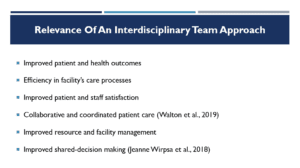
Interdisciplinary team approaches are essential for improved patient and health outcomes. Interdisciplinary team approaches impact how various healthcare professionals relate during care delivery. As an interprofessional model, the approach is linked to improved collaboration and coordination of care within interprofessional teams (
Order this paper